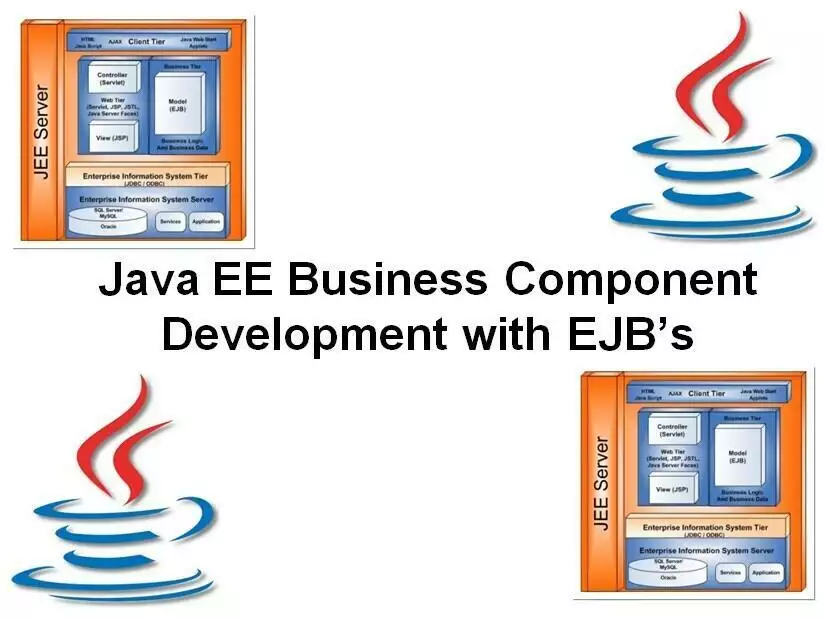-
Learning by doing
-
Trainers with practical experience
-
Classroom training
-
Detailed course material
-
Clear content description
-
Tailormade content possible
-
Training that proceeds
-
Small groups
This course focuses on Enterprise JavaBeans, as specified in the EJB 3.x specification as part of the latest version of Jakarta EE.
Attention is paid to the different types of Enterprise Beans like Session Beans, Message Driven Beans and Singleton Beans.
The Java Naming and Directory Interface (JNDI) is discussed and the simplification of how beans can be located and instantiated through injection. Attention is also payed to the lifecycle of the different types of beans and to concurrency issues.
The important role that annotations play in Jakarta EE and EJB's is discussed as well. Annotations do their work in many places such as in establishing links with resources and the realization of persistence.
Also the use of the EJB Query Language and the implementation of Object Relational Mapping in EJB 3.x is part of the course schedule. Also the use of transactions in a Jakarta EE environment is considered.
Attention is paid to the Jakarta EE security architecture and the various authentication and authorization strategies. JMS and its use in combination with Message Driven Beans is also on the course program.
And finally the focus is on best practices and design patterns in EJB technology.
Java developers that want to learn how to develop of Jakarta EE EJB business components.
To participate in this course knowledge and experience with Java programming is required. Knowledge of Java Web development is beneficial for a proper understanding.
The theory is explained using presentation slides and is interspersed with practical exercises. Demos are used to clarify the theory. All topics that are asked in the Jakarta EE Enterprise JavaBeans Developer Certified Expert Exam (1Z0-895) are discussed. The course material is in English.
After successful completion of the course participants receive an official certificate Jakarta EE EJB Business Components.

Module 1 : Jakarta EE Intro |
Module 2 : Enterprise Java Beans (EJB) |
Module 3 : JNDI and Injection |
| Java Editions Jakarta EE versions Enterprise Applications Jakarta EE Servers Web Components EJB Components JavaBean components Web Services Jakarta EE API's EAR Files Deployment Descriptors Annotations |
Session Beans Statefull and Stateless Life Cycle Session Bean Architecture of an EJB EJB Object at work Client Access Remote versus Local Clients Web Service Clients Singleton Beans Concurrency management strategy Message Driven beans Life Cycle Message Driven Beans |
Naming Services Directory Services Locate resources with JNDI JNDI Architecture JNDI InitialContext JNDI Naming Context EJB Environment Standard JNDI SubContexts Dependency Injection DataSource Injection Injection of EJB References Example EJB Injection |
Module 4 : Java Persistence API |
Module 5 : Callbacks and Listeners |
Module 6 : Session Beans |
| Entity Classes Entity Manager Persistence Context Entity Identity Entity Lifecycle Entity Relationships Persisting Objects Removing Objects Merging Objects Managing Identity |
Life Cycle Callback methods Entity Listeners Life Cycle Callback Rules Signature Life Cycle Callbacks Signature Entity Listeners @PrePersist and @PostPersist @PreRemove and @PostRemove @PreUpdate and @PostLoad Multiple Invocation Callbacks Invocation Order |
Session Beans Overview Stateless Session Beans Event callbacks Asynchronous communication Singleton session bean Singleton concurrency access Stateful Session Beans Passivating and Activating Remote Business Interface Calling Business Methods |
Module 7 : Message Driven Beans |
Module 8 : Timer Service |
Module 9 : Interceptors |
| Messaging Characteristics Publish and Subscribe Point tot Point What is JMS? Message types Message Driven Beans MessageListeners onMessage method |
Timer Service Scheduling Timers Creating Timers Timeout method rules Canceling and Saving Timers Timer Service interface Timer interface Timer handle interface |
What are Interceptors? Interceptor Classes @AroundInvoke Example Interceptor Interceptor Lifecycle Interceptor Types Default Interceptors Exclude Interceptors |
Module 10 : Transactions |
Module 11 : Security |
Module 12 : EJB and Web Services |
| Transactions Demarcating Boundaries Container Managed Bean Managed Client Managed Transaction Attributes Session Synchronization Before Completion After Completion |
Jakarta EE and EJB Security Programmatic Security Jakarta EE authorization strategies Declarative Security Using Programmatic Security Method Permissions DeclareRoles ejb-role-ref role-link |
Web Service Types REST versus SOAP Structure SOAP Message What is WSDL? Stateless Session Bean Endpoint JAX-WS Publishing an Endpoint Web Service Annotations JAX-RS |
Module 13 : EJB Best Practices |
Module 14 : Clustering |
Optional : Annotations and JMX |
| Define Best Practices Benefits of EJB best practices Jakarta EE Patterns Effective Exception Handling EJB Design Patterns Session Facade Composite View Front Controller Business Delegate Service to Worker |
What is clustering? Thin Client Clustering Thick Client Clustering Clustering Stack JGroups and JCache HA-JNDI HA-Smart Proxies SLSBs and SFSBs HTTP Session Replication POJO Clustering |
What are annotations? Single value annotations Normal annotations Meta-Annotations What is JMX? Managed Beans Naming MBeans MBean Server Registering Mbeans Notifications |
